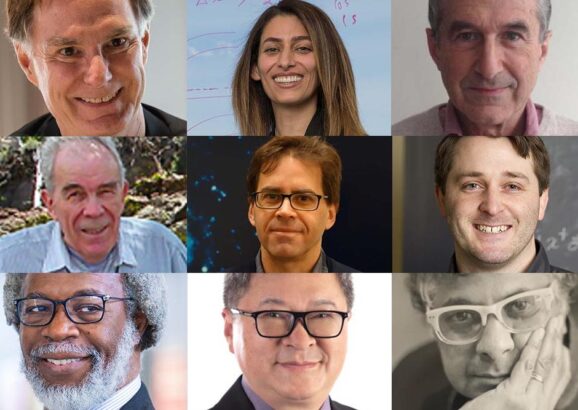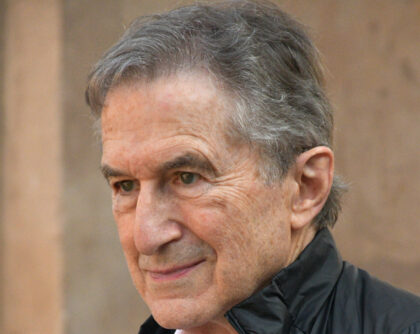Robert L. Jaffe
Research Interests
Robert Jaffe is best known for his research on the quark substructure of matter. In the early 1970s he and his colleagues (Alan Chodos, Kenneth Johnson, Charles Thorn, and Victor Weisskopf) at MIT formulated the first consistent description of quark confinement, the “MIT Bag Model”, and used it to elucidate many aspects of the quark substructure of matter. Earlier, together with John Ellis of CERN, Jaffe formulated a sum rule which relates polarized lepton scattering to the spin substructure of the nucleon. Tests of this sum rule in the late 1980s sparked a renewal of interest in the hadron spin physics. Jaffe, together with students and collaborators, explained the role of higher twist and nuclear effects in deep inelastic lepton scattering. Jaffe and Aneesh Manohar of UC San Diego first described the contribution of quark and gluon orbital angular momentum to the spin of the nucleon. They also discovered and described several quark and gluon distribution functions unique to higher spin targets, including one uniquely sensitive to gluons in nuclear targets. In a series of papers, Jaffe and Xiangdong Ji of the University of Maryland described phenomena associated with transverse spin in hadron substructure and defined “transversity”, a novel quark spin observable now being studied in a variety of experiments. Jaffe was deeply involved in the development of the spin physics program at Brookhaven National Lab.
Jaffe also began the systematic study of exotic hadrons in the 1970s. He proposed that the scalar (spinless) mesons should be interpreted as two quark, two antiquark states, an interpretation which has only recently won wide acceptance. He and Kenneth Johnson launched the theory of glueballs — hadrons made entirely of the gluons which mediate confining forces. Together with Edward Farhi, Jaffe first described the properties of strange quark matter and explored its significance in astrophysics.
In the late 1990’s Jaffe, Farhi, and collaborators developed analytical and computational tools for the study of quantum vacuum energies — Casimir energies — with applications in the Standard Model and beyond. More recently Jaffe’s interest in vacuum fluctuation mediated phenomena has taken a practical turn: In collaboration with Mehran Kardar, Thorsten Emig, Noah Graham, Giuseppe Bimonte, and several students and postdocs, Jaffe developed powerful practical methods to determine the geometry dependence of Casimir forces as they affect micro-electro-mechancial systems. This work, at the intersection of statistical physics, scattering theory, and classical electromagnetism, has revolutionized the both the conceptual framework in which fluctuation forces are considered and has made possible exact calculation of Casimir forces and related phenomena for many systems of experimental interest.
Courtesy of MIT | YouTube
Biographical Sketch
Robert L. Jaffe was born in Bath, Maine in 1946. After attending public schools in Stamford, Connecticut, Robert Jaffe received his AB, summa cum laude in Physics from Princeton, where he was Valedictorian of the Class of 1968. He received his MS (1971) and PhD (1972) degrees from Stanford University. At Stanford, in 1969 together with Joyce Kobayashi and Joel Primack, he founded the Stanford Workshops on Political and Social Issues.
In 1972 Jaffe came to MIT as a postdoctoral research associate in the Center for Theoretical Physics and joined the MIT faculty in 1974. Professor Jaffe has spent sabbatical years at the SLAC, Oxford, Boston University, and Harvard. In 2004 he was a resident scholar at the Rockefeller Foundation Study Center at Bellagio, Italy. Jaffe has served on and chaired numerous program advisory committees, scientific steering committees, and visiting committees at national labs and major universities. Since 2005 Professor Jaffe has been collaborating on the development of a new private university of science and technology in Lahore Pakistan, as a member and chair of its international advisory committee.
In 2008 Jaffe was elected to a term on the American Physical Society’s Panel on Public Affairs (POPA). In 2012 Jaffe was elected to the POPA Chair Line and served as Chair of POPA during 2014. As a member of POPA in 2011, Jaffe led a study of Energy Critical Elements: Securing Materials for Emerging Technologies, which led to Jaffe’s involvement in several energy related studies with collaborators across several departments at MIT.
Professor Jaffe has been deeply engaged in MIT’s physics teaching program. In the 1990s Jaffe developed MIT’s current three term undergraduate quantum mechanics sequence, including the “MIT Physical Review” research paper, which became a model for MIT’s Communication Requirement. In 2005 Jaffe and Professor Washington Taylor began the development of a new course on the “Physics of Energy” at MIT. The course was first taught in 2008 and now serves as the foundational science requirement for MIT’s Energy Studies Minor. Jaffe’s and Taylor’s textbook, “The Physics of Energy“, was published in the spring of 2018 and was awarded the 2019 PROSE award of the Association of American Publishers for the best textbook of 2018 in the physical sciences and mathematics.
In recognition of his teaching and course development, Jaffe was awarded the Science Council Prize for Excellence in Teaching Undergraduates (1983), the Graduate Student Council Teaching Award (1988), and the Physics Department Buechner Teaching Prize both in 1997 and again (jointly with Washington Taylor) in 2009. In January 1998, Jaffe was named a Margaret MacVicar Faculty Fellow in recognition of his contributions to MIT’s teaching program. In 2000, Jaffe was appointed as the Otto and Jane Morningstar Professor of Science at MIT. He was awarded the 2022 Joseph A. Burton Forum Award by the American Physical Society for “bringing a physics perspective into policy discussions in academia and government over the last half-century, from the development of the Stanford Workshops on Social and Political Issues to influential work on policy and education regarding critical elements, energy, and climate.”
Jaffe has been very active in MIT affairs. He was cofounder of the Symposium at MIT, an interdisciplinary faculty program dedicated to improving communication and the exchange of ideas within the faculty. He has served as chair of MIT’s Committee on the Undergraduate Program and of MIT’s Faculty Policy Committee. In 1992 he was elected to a term as Chair of the MIT Faculty, which concluded in June of 1995. From 1998 until 2004, Jaffe served as Director of the Center for Theoretical Physics.
Professor Jaffe is a Member of the American Academy of Arts and Sciences, and a Fellow of the American Physical Society and the American Association for the Advancement of Science.

American Physical Society honors nine with MIT ties for physics research
Faculty, staff, and alumni recognized for outstanding contributions to physics research, education, and policy.
Awards & Honors
- 2022 // Joseph A. Burton Forum Award (APS) "for bringing a physics perspective into policy discussions in academia and government over the last half-century, from the development of the Stanford Workshops on Social and Political Issues to influential work on policy and education regarding critical elements, energy, and climate."
- 2013 // American Academy of Arts and Sciences Member
- 2009 // Buechner Teaching Prize (Jointly with Prof. Washington Taylor) for 8.21 - Physics of Energy, MIT Physics
- 2001 // Appointed Otto (1939) and Jane Morningstar Professor of Physics (MIT)
- 1998-08 // Margaret MacVicar Faculty Fellow, MIT (Honors MIT's Best Teachers)
- 1997 // Buechner Teaching Prize (MIT)
- 1993 // American Association for the Advancement of Science Fellow
- 1988 // Graduate Student Council Teaching Award (MIT)
- 1986 // American Physical Society Fellow "For important contributions to the dynamics of confined quarks and gluons, and the study of glueballs, multiquark hadrons, and quark distributions in nuclei, in the context of QCD."
- 1982 // MIT School of Science Prize for Excellence in Undergraduate Teaching
- 1975 // Sloan Research Fellowship
Key Publications
-
The Physics of Energy (Cambridge University Press; Cambridge; UK; 2018)
-
Energy Critical Elements: Securing Materials for Emerging Technology
